|
|
Bells!
 |
| Above. A small bell from a horse-drawn trolley.
It is marked C.P.N.&.E.R.R.R.CO. Photo by madeleines8940. Below. A
locomotive bell from a Norfolk & Western steam
locomotive. Click
on images for larger versions. |
 |
Since the very beginnings of the industry, bells have been
closely associated with railroading. The horse-drawn railways of the
1800's hung small bells on horses' bridles to indicate their presence,
and bells were used -- and continue to be used -- on virtually all steam
and diesel locomotives.
In his book "Railroad Collectibles",
Baker writes, "About 1840, bells became standard equipment on engines,
but their main function was to warn both humans and animals to watch
out for the coming train. In the very early days, a man on horseback
rode ahead of the locomotive waving a flag and shouting 'The train is
coming.' When a bell was added, it was the fireman's job to ring it,
and many a fireman would develop such a distinctive touch on the bell
that his friends and family would become familiar with its tone and cadence.
When President Lincoln's body was carried by train from Chicago to Springfield
in 1865, the engine's muffled bell tolled the entire distance." (Baker,
pg 161.)
When a locomotive was scrapped, the
bell, along with maybe the whistle and builder's plates, were often
the only items salvaged. Some salvaged
bells had a second working life in churches, camps, farms and factories,
while others were simply used for presentation or ornamental purposes.
More than one railroad official had a polished locomotive bell decorating
his office. While some bells were lost to metal scrap drives during the
world wars, many have survived to become a specialty item for contemporary
railroadiana collectors.
We say "specialty" because locomotive bells are *heavy" and
not for everyone. Not only do they take space to display and
effort to restore, but they require a crew and/or equipment just to move.
Bells and their accompanying cradles can weigh hundreds of pounds, and
it's a good guess that attempts to move a heavy bell have been responsible
for more than one medical bill. However, few railroad artifacts match
the presence and beauty of a gleaming, polished locomotive bell. And
few railroadiana items -- with maybe the exception of whistles -- can
so dramatically announce a collector's love of railroads to the entire
neighborhood.
Here are some points about bells:
- As a general rule, authentic railroad bells are either large, massive
locomotive bells (ranging from 12" to 17+" in diameter) or very
small bells (around 3" diameter) from
horse-drawn trolleys. Most locomotive bells are around
15" to 16" in diameter, measured on the outside of the widest
end.
- Large steam locomotive bells were made of cast metal --
usually bronze or brass. Some smaller locomotive bells, such as those
used on diesel locomotives were made of iron or steel.
- While the bell itself
was one piece, the bell assembly typically consisted of the cradle,
which attached to the locomotive body, the yoke, which fit into the
cradle and attached to and swung with the bell, the clapper, which
was the metal piece that struck the bell on the inside causing the
ring, and the "pull-arm",
which was a lever to which a pull rope was attached. There also were
various hex-nuts and fasteners as part of a bell assembly.
- Bell assemblies differed in the bases of the yokes and
how they were mounted. On some early, smaller steam locomotives that
had a lot of height clearance, bells used top-mounted pedestal yokes.
Later in the steam era when engines became much larger, bells were
hung on front-mounted yokes for clearance purposes or top-mounted yokes
that allowed the bell to swing. Still later, diesel locomotives and
engines like the Pennsylvania Railroad's GG1 Electric used bells that
were attached to the frame of the locomotive and that did not swing
at all. Such bells were actuated or rung by an air ringer. Top mounted
bells are most popular with collectors because they display the best
and are usually associated with large locomotives of the steam era.
- Horse-bells were often marked with cast initials indicating the trolley
line, but locomotive bells were usually not marked for the railroad
with a few exceptions (see picture below).
- On Identifying the Origin of Bells...Bells are sometimes found
with stamped or cast numbers, and a common question concerns how easy
it is to identify the railroad and locomotive based on these numbers.
According to one experienced collector, "You
will often find numbers stamped in the top of a bell. The railroad
would stamp the locomotive number into the top of the bell each time
the bell was used on a different locomotive. I have seen bells with
as many as three or four numbers stamped in the top. This would be
on large roads of course. In general the casting number is not a help,
but on a Baldwin locomotive, the bell would sometimes have the Baldwin
code stamped into it like the back of their builder's plates had until
1930 or 1931. We can sometimes trace the info back through SMU in Texas.
They have most of the Baldwin records and can trace the numbers when
you make an inquiry. In general bells and headlights are difficult
[to trace] unless you have a record to trace the origin of the item."
Another experienced collector says, "The numbers on the yoke and
rocker are casting numbers -- sort of like part numbers that the manufacturers
would use. They have nothing to do with the engine number since on
any specific class of locomotive, all of the part numbers would be
the same. The bell itself *might* have a number stamped into the top
of it. That is the only way that I know, with one very rare exception,
and this exception is an extremely rare occurrence. Sometimes a guy
might have painted the engine number on the bell, but this did not
happen very often." In general, the best way to know the origin of
the bell is through the seller who has some sort of documentation.
For example, the seller may have originally bought the bell
from the railroad and therefore personally knows what locomotive
it came from. Of course as time goes one, such personal knowledge may
become lost. Update: We have received many emails asking for bell identification information. Sorry, but we cannot answer questions about the age or origin of bells. All the information that we have on locomotive bells is on this page.
- Since it can be difficult to trace the origin of a bell through markings,
it is especially important for current owners to document everything
that they know about their bells as a means of preserving history.
For example, they may have been told details by the previous owner
-- railroad name, locomotive type and number, how it was acquired,
etc. -- that would otherwise be lost to time if not written down. This
has already happened with many bells.
- When purchasing a bell, condition is important since most collectors
eventually hope to have a shining display piece. Some questions
to ask are: Is the bell polished? Tarnished? Beat up? Dented? Been
used by a bunch of kids for target practice? Does the bell have a
yoke and rocker? (If it is just the bell casting itself, you can't
ring it, so what's the point?) Bell restoration can be a very lengthy
and time-consuming process, and there are many stories in the hobby
of collectors spending a lot of blood, sweat, tears and $$$ in a bell
restoration project. If successful though, the result can be the crown
jewel of a collection. See the bell restoration advice suggested by
collectors on our restoration
page.
- It is common to find small, railroad-marked hand bells in internet
auctions and antique shows, sometimes accompanied by fanciful stories
about conductors using them to announce that the train was leaving.
While historians cannot swear that no conductor ever used a hand bell
(particularly in the early days of primitive railroading), the use
of hand bells was certainly not standard practice among conductors.
The railroad-marked hand bells that show up in today's market are modern
imports -- fakes. See our fakes
pages.
- The cost of a nice locomotive bell can be well over a thousand dollars.
As with any historic artifact, older and rarer bells command higher
prices. For example, a bell from, say, a Rogers steam locomotive from
the 1800's, will command a higher price than a bell from a 1950's-era
diesel locomotive. Similarly, a nice big, brass bell off of a sexy
passenger engine or a great hulking freight engine is generally worth
more than a small steel bell off of a switch engine.
Here are some pictures and additional information about bells:
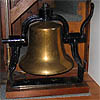 |
 |
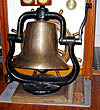 |
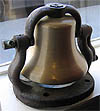 |
| Above far left: A bell from
a Carolina, Clinchfield & Ohio Railway steam locomotive used
as a presentation piece. Above
middle left: The plaque attached to the base
of the CC&O Ry bell with an inscription reading,"This bell
is from Carolina Clinchfield and Ohio Railway steam locomotive Number
411. A 2-8-2 Class K-4 Built by American Locomotive Company January
1923 and retired September 1952. J W Thomas, General Manager,
Clinchfield Railroad". Above
middle right: An exceptionally large bell with a diameter of
17 1/2" from
a Chesapeake & Ohio Railway steam locomotive. Above far
right: A
bell from an Alliquippa & Southern steam locomotive, photographed
in an antique store window (but not for sale). |
 |
 |
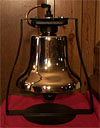 |
 |
Above far left: A locomotive bell used to
decorate a hearth; it is 14 1/2" in diameter, mounted
on a mahogany base, and believed to be a Baltimore & Ohio
Railroad bell due to the fact that a very similar one is pictured
in a circa 1950 B&O gift shop catalog. Above middle
left. The catalog illustration from a 1950's B&O catalog
offering authentic locomotive bells for $185. Above
middle right: A bell from Bessemer & Lake Erie SD-18
diesel locomotive #856. The bell
is 12" in
diameter and 9" tall to the top plus 3" for the stem. This
bell was mounted in a frame mount on the locomotive. Click
here for a picture of the SD-18, the bell being barely visible
behind the fuel tank. Above far
right. A bell from an early Baltimore & Ohio steam locomotive
photographed at the 2006 Gaithersburg railroadiana show.
|
 |
 |
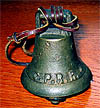 |
 |
| Above far left: An older style bell with a
pedestal yoke from a steam locomotive; the bell is only 12 1/2" in
diameter and marked
"B&O RR" (Baltimore & Ohio
Railroad). Above
middle left. Closeup
of the "B&O RR" marking. Above
middle right: A horse bell from a horse-drawn
trolley railroad marked "C.P.R.R.". Above far
right. The inside of the same "C.P.R.R." bell
. |
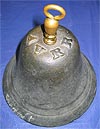 |
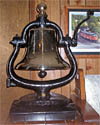 |
 |
 |
Above far left. A
horse bell marked "A.V.R.R.",
probably from the Allegheny Valley Railway; Above
middle left. A heavy bell from a Bessemer
& Lake Erie Railroad steam locomotive. The bell is 31" tall
not counting the base which was made by a collector for display. Above
middle and far right. Two views of a massive collection
of locomotive bells, most from the Great Northern Railway.
|
Notes.
- Special thanks to all the collectors who provided
photos and/or information for this page.
Other Sources and Further Reading.
- Baker,
Stanley. Railroad
Collectibles: Fourth Edition. Collector Books, PO Box
3009, Paducah, KY 42001.
- Cummins, Doug. "Jingle Bells". The Railroadiana Express,
Winter, 2003, pg 10-11.
- Hoffer, Rob. "All the Bells & Whistles". The Railroadiana
Express, Winter, 1997, pg 6-7.
- Marks, Richard. "Horse Bells". The Railroadiana Express,
Summer, 1986, pg 11.
- Plaquet, Roger. "Railroad Horse Call Bells". Key, Lock & Lantern,
Fall, 2004, pg 7-8.
- Smout, Mike. "For Whom the Bell Tolls". The Railroadiana
Express, Spring, 1997, pg 10-11.
|